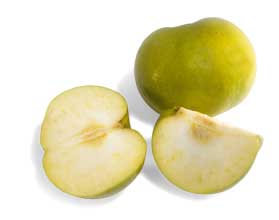Black Sapote
A chocolate pudding fruit. Looks like a tomato of medium size which is brown inside and dark green from outside. It tastes sweet and is rich in potassium, Vitamin C and a good source of fiber.
 Full List of Fruits
Full List of Fruits  Black Sapote
Black Sapote
Scientific Name:Diospyros digyna
Black Sapote Fruit
"NATURES NATURAL CHOCOLATE"

Black Sapote Varities
Click on the below Black Sapote you wish to find about
The various Black Sapote are distinguished as botanical species rather than as cultivars. The following are those most utilized for food:
1.Zapote Blanco
 This delicious, extremely fragile fruit is also called as sleep sapote
This delicious, extremely fragile fruit is also called as sleep sapote  This fruit has sweet, creamy pulp that's fruit salads or shakes are in wonderful.
This fruit has sweet, creamy pulp that's fruit salads or shakes are in wonderful.  They mostly arrive in the summer.
They mostly arrive in the summer. They are usually sold when they are hard since they are vulnerable to the plant virus attack easily when they become ripe.
They are usually sold when they are hard since they are vulnerable to the plant virus attack easily when they become ripe. This thin inedible fruit skin changes from green to yellow when it ripes
This thin inedible fruit skin changes from green to yellow when it ripes
2.Mamey Sapote
 The fruit is large, round and has a thick, brown skin. The flesh is firm, with a pleasant peach-apricot flavour.
The fruit is large, round and has a thick, brown skin. The flesh is firm, with a pleasant peach-apricot flavour. A mamey sapote is ripe when the flesh is pink when a fleck of the skin is removed. The flesh should give slightly, as with a ripe kiwifruit.
A mamey sapote is ripe when the flesh is pink when a fleck of the skin is removed. The flesh should give slightly, as with a ripe kiwifruit. They are great for eating out of hand, or for making fruit salads or smoothies.
They are great for eating out of hand, or for making fruit salads or smoothies. Fruit mature over summer after up to 18 months after flowering.
Fruit mature over summer after up to 18 months after flowering.
3.White Sapote
 White sapote (Casimiroa edulis), also known as custard apple and cochitzapotl in Nahuatl.
White sapote (Casimiroa edulis), also known as custard apple and cochitzapotl in Nahuatl.  It is commonly round or oval with a bumpy, irregular surface. Fruit are greenish-yellow skin, creamy white to yellowish, soft, sweet flesh.
It is commonly round or oval with a bumpy, irregular surface. Fruit are greenish-yellow skin, creamy white to yellowish, soft, sweet flesh. Generally available from May through August and September.
Generally available from May through August and September. Sapotes contain a fair amount of vitamin A, are a good source of vitamin C, have a relatively high amount of potassium.
Sapotes contain a fair amount of vitamin A, are a good source of vitamin C, have a relatively high amount of potassium.

- 1 cup black sapote mashed in brandy
- Lady fingers or other plain cake
- 1 cup whipped cream
- Line a deep glass dish with ladyfingers, or two layers of finely cut plain cake to form a shell.
- Fold brandied black sapote on top of the cake. Two hours of fine cooling. Top with whipped cream.

- 250 ml black sapote puree
- 1 tbl sp gelatine (sprinkled over 2 tbsp boiling water)
- 60 grams castor sugar
- 30 ml tia maria/creme de cacao or brandy
- 600 ml whipped cream
- Blend sapote, sugar and alcohol together until sugar has dissolved.
- Add dissolved gelatine and whipped cream.



















